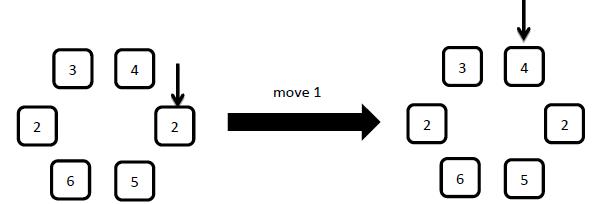
| Online Judge | Online Exercise | Online Teaching | Online Contests | Exercise Author |
|
F.A.Q Hand In Hand Online Acmers |
Best Coder beta VIP | STD Contests DIY | Web-DIY beta |
Looploop
Time Limit: 2000/1000 MS (Java/Others) Memory Limit: 32768/32768 K (Java/Others)Total Submission(s): 2991 Accepted Submission(s): 1007
Problem Description
XXX gets a new toy named Looploop. The toy has N elements arranged in a loop, an arrow pointing to one of the elements, and two preset parameters k1 and k2. Every element has a number on it.

The figure above shows a Looploop of 6 elments. Let's assuming the preset parameter k1 is 3, and k2 is 4.
XXX can do six operations with the toy.
1: add x
Starting from the arrow pointed element, add x to the number on the clockwise first k2 elements.

2: reverse
Starting from the arrow pointed element, reverse the first k1 clockwise elements.

3: insert x
Insert a new element with number x to the right (along clockwise) of the arrow pointed element.

4: delete
Delete the element the arrow pointed and then move the arrow to the right element.

5: move x
x can only be 1 or 2. If x = 1 , move the arrow to the left(along the counterclockwise) element, if x = 2 move the arrow to the right element.

6: query
Output the number on the arrow pointed element in one line.

XXX wants to give answers to every query in a serial of operations.

The figure above shows a Looploop of 6 elments. Let's assuming the preset parameter k1 is 3, and k2 is 4.
XXX can do six operations with the toy.
1: add x
Starting from the arrow pointed element, add x to the number on the clockwise first k2 elements.

2: reverse
Starting from the arrow pointed element, reverse the first k1 clockwise elements.

3: insert x
Insert a new element with number x to the right (along clockwise) of the arrow pointed element.

4: delete
Delete the element the arrow pointed and then move the arrow to the right element.

5: move x
x can only be 1 or 2. If x = 1 , move the arrow to the left(along the counterclockwise) element, if x = 2 move the arrow to the right element.

6: query
Output the number on the arrow pointed element in one line.

XXX wants to give answers to every query in a serial of operations.
Input
There are multiple test cases.
For each test case the first line contains N,M,k1,k2(2¡Ük1<k2¡ÜN¡Ü105, M¡Ü105) indicating the initial number of elements, the total number of operations XXX will do and the two preset parameters of the toy.
Second line contains N integers ai(-104¡Üai¡Ü104) representing the N numbers on the elements in Looploop along clockwise direction. The arrow points to first element in input at the beginning.
Then m lines follow, each line contains one of the six operations described above.
It is guaranteed that the "x" in the "add","insert" and "move" operations is always integer and its absolute value ¡Ü104. The number of elements will never be less than N during the operations.
The input ends with a line of 0 0 0 0.
For each test case the first line contains N,M,k1,k2(2¡Ük1<k2¡ÜN¡Ü105, M¡Ü105) indicating the initial number of elements, the total number of operations XXX will do and the two preset parameters of the toy.
Second line contains N integers ai(-104¡Üai¡Ü104) representing the N numbers on the elements in Looploop along clockwise direction. The arrow points to first element in input at the beginning.
Then m lines follow, each line contains one of the six operations described above.
It is guaranteed that the "x" in the "add","insert" and "move" operations is always integer and its absolute value ¡Ü104. The number of elements will never be less than N during the operations.
The input ends with a line of 0 0 0 0.
Output
For each test case, output case number in the first line(formatted as the sample output). Then for each query in the case, output the number on the arrow pointed element in a single line.
Sample Input
5 1 2 4 3 4 5 6 7 query 5 13 2 4 1 2 3 4 5 move 2 query insert 8 reverse query add 2 query move 1 query move 1 query delete query 0 0 0 0
Sample Output
Case #1: 3 Case #2: 2 8 10 1 5 1
Source
| Home | Top |
Hangzhou Dianzi University Online Judge 3.0 Copyright © 2005-2025 HDU ACM Team. All Rights Reserved. Designer & Developer : Wang Rongtao LinLe GaoJie GanLu Total 0.001000(s) query 1, Server time : 2025-02-19 06:51:26, Gzip enabled |
Administration |